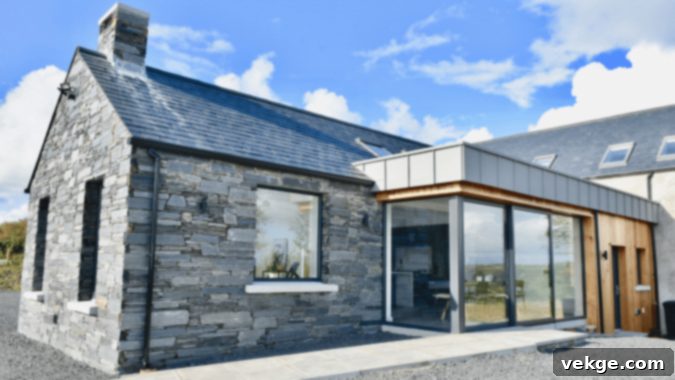Future-Proof Your Home: Long-Term Improvements for Lasting Family Comfort and Security
The journey of homeownership is deeply personal, often intertwined with dreams of family, stability, and a sanctuary that can withstand the test of time. Whether you’re excitedly stepping into a new home or comfortably settled in your long-term abode, the future well-being and comfort of your family within that space are undoubtedly paramount. In an ever-evolving world, creating a home that offers enduring security and adaptability provides immense peace of mind.
This comprehensive guide delves into long-term home improvement solutions designed not just for immediate satisfaction, but for building a resilient, comfortable, and sustainable living environment for generations. By thoughtfully investing in these upgrades, you can enhance your property’s value, reduce future maintenance costs, and ensure your home remains a haven that truly supports your family’s evolving needs and aspirations.
1. Strategic Planning: Laying the Foundation for Your Forever Home

Just like any successful endeavor, future-proofing your home begins with a meticulously crafted plan. This isn’t just about superficial changes; it’s about envisioning your home’s trajectory over decades. Start by conducting a thorough assessment of your current living space. What are its strengths? What areas are prone to wear and tear? More importantly, where do you foresee your family in 5, 10, or even 20 years within these walls? Will your needs shift as children grow, or as you plan for retirement? These critical questions will form the bedrock of your long-term adjustments.
Given the significant nature of these decisions, it’s easy to feel overwhelmed. Remember, you don’t have to navigate this alone. Involve every family member in the planning process, encouraging their input and ideas. This collaborative approach transforms future-proofing into a shared adventure, ensuring the resulting space truly reflects the collective dreams and requirements of everyone living under your roof. Consider creating a “home vision board” or a detailed list of short-term and long-term goals, complete with a realistic budget and a timeline. Consulting with architects, interior designers, or general contractors early on can also provide invaluable insights into feasibility and potential innovative solutions you might not have considered.
2. Optimize Your Space: Designing for Flexible Living
Before embarking on costly renovations, take a pragmatic look at your home’s existing infrastructure. How can you maximize what you already have? Often, creative reorganization and minor structural changes can unlock significant potential. For instance, if you’re moving into a new property or seeking to revitalize a long-standing residence, explore innovative ways to reconfigure the division of rooms. The goal is to create flexible living spaces that can adapt to changing family dynamics over time.
Could that seldom-used guest bedroom transform into a dynamic home office, a vibrant play area for children, or even a serene multi-purpose den? Perhaps removing a non-load-bearing wall could open up a cramped living area, fostering a more connected, open-plan environment. Conversely, if privacy is a growing concern, consider adding internal sliding doors or movable partitions to create distinct zones when needed. Think about clever storage solutions, built-in shelving, and modular furniture that can serve multiple purposes. Prioritizing your family’s long-term interests and anticipated needs will guide you toward an optimized layout that enhances daily living and future adaptability, significantly boosting your home’s functionality and appeal.
3. Prioritizing Safety and Resilience: Peace of Mind for Years to Come
Ensuring the enduring comfort of your home inextricably links to prioritizing safety and resilience. A secure home provides an unparalleled sense of relief and well-being for your loved ones. Proactive measures against potential hazards, both immediate and long-term, are crucial for future-proofing your property. Here are key areas to focus on when enhancing home security and resilience:
- Essential Safety Measures: Begin with the non-negotiables. Ensure you have functioning smoke detectors on every floor and in sleeping areas, carbon monoxide detectors, and fire extinguishers readily accessible. Regularly test and maintain these devices. High-quality locks on all exterior doors and windows are fundamental.
- Advanced Security Systems: Consider investing in a modern security system. Options range from basic alarm systems to sophisticated smart home setups with integrated cameras, motion sensors, and remote monitoring capabilities. These systems not only deter intruders but can also provide immediate alerts in emergencies.
- Structural Integrity and Weather Resilience: Beyond security systems, think about the physical robustness of your home. If your property is older, consider upgrading to double or triple-glazed windows. These not only offer superior insulation, enhancing energy efficiency, but also provide a significant barrier against forced entry. Evaluate your roof’s condition, foundation, and exterior cladding. Investing in durable, weather-resistant materials can protect your home from harsh elements and reduce long-term maintenance costs, ensuring its structural integrity for decades.
- Disaster Preparedness: Depending on your geographical location, future-proofing might also involve preparing for natural disasters. This could mean installing flood barriers, securing heavy furniture to walls in earthquake-prone areas, or reinforcing your home against high winds. A well-prepared home is a resilient home, offering true security in unpredictable times.
4. Embracing Energy Efficiency and Sustainability
The energy system powering your home is a critical aspect of its long-term comfort, cost-effectiveness, and environmental footprint. While traditional gas boilers and grid electricity have been the norm, a future-proofed home embraces more sustainable and efficient alternatives. Investing in energy-efficient upgrades offers dual benefits: significant savings on utility bills and a reduced environmental impact.
- Renewable Energy Sources: For those ready to make a substantial long-term investment, installing renewable energy sources like solar panels or ground-source heat pumps can drastically reduce your reliance on fluctuating external energy markets. These systems not only provide clean energy but can also increase your property’s value and offer potential government incentives or rebates.
- Maximizing Insulation: One of the most impactful yet often overlooked upgrades is improving your home’s insulation. Proper insulation in walls, attics, and floors prevents heat loss in winter and heat gain in summer, ensuring a more stable indoor temperature with less energy consumption.
- Smart Energy Management: Integrate smart thermostats and energy management systems. These devices learn your family’s routines, optimize heating and cooling schedules, and can be controlled remotely, giving you precise control over your energy usage.
- Efficient Appliances and Heating Systems: When replacing appliances, always opt for energy-star rated models. For heating, consider upgrading your existing system. Researching options like the best combi boiler for your home or exploring modern alternatives like air-source heat pumps can lead to considerable long-term savings and improved comfort. Switching to LED lighting throughout your home is a simple yet effective way to cut electricity consumption.
By proactively addressing your home’s energy performance, you’re not just saving money; you’re contributing to a healthier planet and securing your family’s comfort against rising energy costs.
5. Blending Form and Function: Creating a Home That Grows With You
Your home serves as a sanctuary, a place where you and your loved ones can relax, grow, and thrive. While safety, efficiency, and smart planning are crucial for future-proofing, the aesthetic and emotional comfort of your living space should never be overlooked. A truly future-proofed home seamlessly blends functionality with enduring style and personal joy, ensuring it remains a place you love coming back to for years to come.
- Timeless Design and Durable Materials: When making long-term adjustments, opt for classic, timeless design elements over fleeting trends. Choose durable, high-quality materials for flooring, countertops, and fixtures that can withstand daily wear and tear and are easy to maintain. These investments pay off in longevity and sustained aesthetic appeal.
- Ergonomics and Accessibility: Consider the long-term needs of your family, including potential accessibility requirements as loved ones age. Features like wider doorways, curbless showers, lever-style door handles, and thoughtful lighting can make a significant difference in comfort and usability for everyone.
- Personal Touches for Well-being: Don’t forget to infuse your home with personality and elements that bring joy. This could be through vibrant wall colors, meaningful artwork, comfortable furniture arrangements, or dedicated spaces for hobbies and relaxation. Natural light and good ventilation also play a huge role in overall well-being and the feeling of spaciousness. A home that reflects your family’s unique spirit and offers a sense of calm and happiness is truly future-proof, fostering emotional well-being alongside physical comfort.
6. Integrating Smart Home Technology for Modern Living
The rapid advancement of smart home technology presents exciting opportunities for future-proofing your residence, enhancing both convenience and security. Integrating these technologies now can significantly boost your home’s adaptability and appeal for years to come.
- Automated Lighting and Climate Control: Smart lighting systems allow you to control brightness and ambiance, often remotely, improving energy efficiency. Paired with smart thermostats, you can create optimized climate zones, ensuring comfort while minimizing energy waste.
- Enhanced Security and Monitoring: Beyond basic alarm systems, smart security solutions offer connected cameras, smart doorbells with two-way communication, and intelligent locks that can be managed from your smartphone. This provides an extra layer of protection and peace of mind, allowing you to monitor your home from anywhere.
- Voice Assistants and Centralized Control: Many smart homes are now centered around voice-activated assistants, allowing seamless control of various devices. A centralized hub can integrate everything from entertainment systems to blinds and appliances, simplifying daily routines and making your home more intuitive.
- Future Compatibility: When choosing smart devices, prioritize systems that are compatible with open standards or major platforms (like Apple HomeKit, Google Home, Amazon Alexa) to ensure longevity and easier integration with future technologies. Smart home technology isn’t just about gadgets; it’s about creating an intelligent living environment that anticipates and responds to your family’s needs, enhancing comfort, efficiency, and security for the long haul.
In Conclusion
Home improvement projects are far more than quick fixes or aesthetic updates; they are strategic investments in your family’s long-term comfort, security, and happiness. By adopting a proactive and thoughtful approach to future-proofing your home, you’re not just renovating a structure; you’re cultivating a resilient and adaptable sanctuary.
From meticulous planning and optimizing your living spaces to prioritizing robust safety measures, embracing sustainable energy solutions, and designing with both beauty and function in mind, each step contributes to a home that can gracefully evolve with your family’s changing needs. Don’t underestimate the power of integrating smart technology or the lasting value of personal touches that make a house truly feel like home. With a solid, long-term plan in hand, you can embark on these adjustments today, ensuring your property remains a cherished, comfortable, and secure haven for generations to come.
